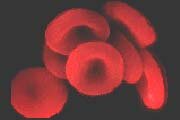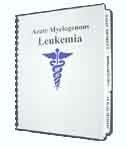 |
||
| HOME | ||
 |
||
| Acute Myelogenous Leukemia (AML) |
||
 |
||
| Other Leukemia Types (ALL / CLL / CML / HCL) |
||
 |
||
| Myelodysplastic Syndrome | ||
 |
||
| Symptoms and Diagnosis | ||
 |
||
| Leukemia Treatment Options | ||
 |
||
| " Chemotherapy | ||
 |
||
| " Blood Stem Cell Transplants | ||
 |
||
| " Radiation and Surgery | ||
 |
||
| " Chemo Side Effects | ||
 |
||
| " Clinical Trials Info | ||
 |
||
| " Coping with Leukemia | ||
 |
||
| " What to Ask Your Doctor | ||
 |
||
| Financial Assistance | ||
 |
||
| At Risk Jobs/Exposure | ||
 |
||
| Leukemia Resources | ||
 |
||
| Survivor's Story | ||
 |
||
| Leukemia News | ||
 |
||
|
Search for information:
|
||

|
Leukemia Cancer News - Return to Menu Protein that promotes survival of stem cells might be key to poor leukemia prognosis Finding that Mcl-1 blocks cell suicide in hematopoietic stem cells also suggests that interfering with this protein might improve leukemia treatment 23-Feb-2005 - The complex and life-sustaining series of steps by which hematopoietic stem cells (HSC) give rise to all of the body's red and white blood cells and platelets has now been discovered to depend in large part on a single protein called Mcl-1. This finding, from an investigator at St. Jude Children's Research Hospital, is published in the February 18 issue of Science. Mcl-1 blocks the biochemical cascade of reactions that trigger apoptosis ("cell suicide") of HSCs, according to Joseph Opferman, Ph.D., assistant member of St. Jude Biochemistry. Expression of Mcl-1 thus ensures that HSCs continue to thrive and multiply so they can complete the task of making huge numbers of blood cells. This process is extremely important during the initial development of the blood system before birth. Expression of Mc1-1 is also crucial for maintaining blood cells throughout life as red and white cells and platelets die and must be replaced. HSCs are also needed to rebuild the blood system of patients undergoing chemotherapy and radiation for cancer. Opferman completed work on this project while a member of Stanley Korsmeyer's laboratory at the Dana-Farber Cancer Institute (Boston). Mcl-1 belongs to the Bcl-2 family of proteins. Some of these family members promote apoptosis, while others prevent it. "Other researchers have previously shown that members of the Bcl-2 family that block apoptosis are involved in regulating the number of HSCs and progenitor cells," Opferman said. "But our study showed for the first time that a single such Bcl-2 family protein--Mcl-1--is essential for promoting the survival of these cells." Progenitor cells are precursors arising from HSCs; these cells produce daughter cells that become increasingly specialized and then produce specific types of blood cells, such as B lymphocytes--immune cells that produce antibodies. "Understanding the role of Mcl-1 in apoptosis and how this gene is regulated will help my lab at St. Jude understand why some cases of leukemia are so difficult to cure," Opferman said. "The more we understand these diseases, the more likely we'll be able to design improved treatments for them. This fits into the St. Jude mission of finding cures for catastrophic diseases of childhood, such as leukemia, in order to save lives." The importance of Mcl-1 lies in the differing roles it plays in health and disease. "On one hand, this protein keeps HSCs and progenitor cells alive and multiplying so the body can maintain its needed supply of blood cells," he said. "However, Mcl-1 also prevents the abnormal white blood cells found in leukemia from undergoing apoptosis in response to chemotherapy or radiation. This makes the leukemia cells resistant to treatments designed to damage the cell so it undergoes apoptosis." Opferman is continuing his studies of Mcl-1 at St. Jude to better understand the role this protein plays in both normal hematopoiesis (production of blood cells) as well as in potentially fatal blood cancers. Opferman and his colleagues had previously shown that Mcl-1 is needed to ensure that HSCs and progenitor cells produced by HSCs are able to generate more specific cells, such as the immune cells known as B and T lymphocytes. In the Science study, Opferman's team genetically modified mice so that the gene for Mcl-1 could be specifically deleted from the genome of HSCs and progenitor cells. Upon genetic deletion, these mice developed anemia and had severely reduced numbers of bone marrow (BM) cells, such as HSCs and progenitor cells. This was strong evidence that Mcl-1 was needed to maintain these cell populations. The team also demonstrated that BM cells lacking Mcl-1 did not multiply when removed from mice and cultured in the laboratory. However, BM cells with the gene continued to flourish. In contrast, liver cells were unaffected following loss of Mcl-1, demonstrating that Mcl-1 is important only in certain cell types. Finally, the investigators showed that growth factors (natural proteins that stimulate cells to grow), such as the "stem cell factor," trigger the expression of the Mcl-1 gene. This was an important clue to how cells control the powerful effects of Mcl-1. Other authors of this study are Hiromi Iwasaki, Christy C. Ong, Heikyung Suh, Shin-ichi Mizuno, Koichi Akashi and Stanley J. Korsmeyer (Dana-Farber Cancer Institute). Contact: Bonnie Cameron ### St. Jude Children's Research Hospital St. Jude Children's Research Hospital is internationally recognized for its pioneering work in finding cures and saving children with cancer and other catastrophic diseases. Founded by late entertainer Danny Thomas and based in Memphis, Tenn., St. Jude freely shares its discoveries with scientific and medical communities around the world. No family ever pays for treatments not covered by insurance, and families without insurance are never asked to pay. St. Jude is financially supported by ALSAC, its fundraising organization. For more information, please visit www.stjude.org. Regimen Consisting of Fludara®, Cytoxan® and Rituxan® Highly Active in Recurrent Chronic Lymphocytic Leukemia According to results recently published in the Journal of Clinical Oncology, the chemotherapy treatment combination consisting of the agents Fludara (fludarabine) and Cytoxan (cyclophosphamide) plus the targeted agent Rituxan (rituximab) provides promising anticancer responses in patients with chronic lymphocytic leukemia (CLL) that has stopped responding to standard therapies. CLL is a cancer involving the lymph (immune) system, which includes lymph nodes, blood and blood vessels found throughout the body, the spleen, thymus and tonsils. High quantities of this cancer are present throughout circulating blood and in bone marrow (spongy material inside large bones that produces blood forming cells). CLL is characterized by the production of atypical lymphocytes. Lymphocytes are specialized immune cells that exist in two forms: B and T-cells. These cells are produced in the bone marrow and each serves a specific function in fighting infection. The large majority of CLL cases involve mature B-lymphocytes that tend to live much longer than normal, accumulating in the blood, bone marrow, lymph nodes and spleen. This results in overcrowding of these areas and suppression of the formation and function of blood and immune cells. Additionally, the cancerous lymphocytes themselves do not function normally, leading to a further decrease in the ability of the body to fight infection. CLL is considered a slow-growing or low-grade cancer. Treatment for CLL may include chemotherapy, radiation therapy, biological therapy and/or stem cell transplantation. Treatment options are limited for patients who have received several prior therapies or have stopped responding to standard therapies (refractory). The chemotherapy agents Fludara and Cytoxan can be used alone as standard treatment for CLL. Results have also indicated that the combination of Fludara and Rituxan is active in the treatment of CLL. Rituxan is a monoclonal antibody that is produced through laboratory processes to bind to a portion (CD20) of B-cells, the most common cancerous type of cells in CLL. The binding action stimulates the immune system to attack the cell to which Rituxan is bound. Rituxan is FDA approved for the treatment of relapsed or refractory low-grade or follicular, CD20+, B-cell non-Hodgkin's lymphoma. Researchers have been evaluating Rituxan alone and in combination with other therapies for the treatment of CLL. Researchers from the MD Anderson Cancer Center recently conducted a clinical trial to evaluate the treatment combination consisting of Fludara, Cytoxan and Rituxan in 177 patients with recurrent or refractory CLL. Patients had received an average of two prior therapies. Eighty-one percent of patients had received prior treatment with Fludara, and twelve percent had received prior treatment with Rituxan. Following treatment with Fludara/Cytoxan/Rituxan, anti-cancer responses were high73 percent of patients had a partial response and 25 percent achieved a complete disappearance of detectable cancer (complete response). The average time to cancer progression was 28 months. The average survival time for patients who achieved an anti-cancer response following treatment has not yet been reached. The researchers concluded that the treatment combination consisting of Fludara, Cytoxan and Rituxan provides high anti-cancer activity in patients with recurrent or refractory CLL. Patients with recurrent or refractory CLL may wish to speak with their physician regarding their individual risks and benefits of treatment with this particular regimen. Reference: Wierda W, OBrien S, Wen S, et al.Chemoimmunotherapy with Fludarabine, Cyclophosphamide, and Rituximab for Relapsed and Refractory Chronic Lymphocytic Leukemia. Journal of Clinical Oncology 2005;23:4070-4078.
|
|
|


